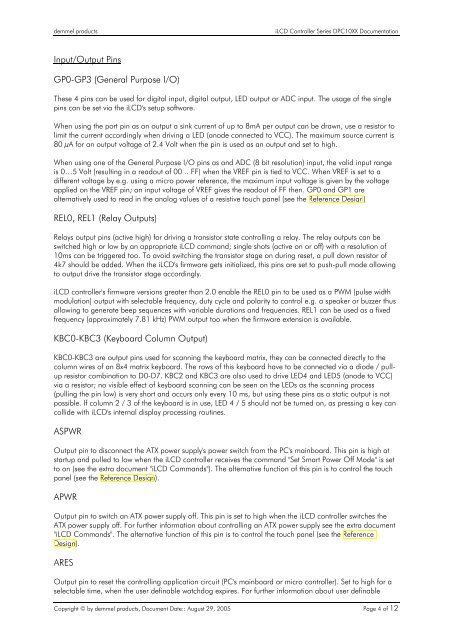iLCD Controller DPC10XX Series Documentation
iLCD Controller DPC10XX Series Documentation
iLCD Controller DPC10XX Series Documentation
You also want an ePaper? Increase the reach of your titles
YUMPU automatically turns print PDFs into web optimized ePapers that Google loves.
demmel products <strong>iLCD</strong> <strong>Controller</strong> <strong>Series</strong> <strong>DPC10XX</strong> <strong>Documentation</strong><br />
Input/Output Pins<br />
GP0-GP3 (General Purpose I/O)<br />
These 4 pins can be used for digital input, digital output, LED output or ADC input. The usage of the single<br />
pins can be set via the <strong>iLCD</strong>'s setup software.<br />
When using the port pin as an output a sink current of up to 8mA per output can be drawn, use a resistor to<br />
limit the current accordingly when driving a LED (anode connected to VCC). The maximum source current is<br />
80 µA for an output voltage of 2.4 Volt when the pin is used as an output and set to high.<br />
When using one of the General Purpose I/O pins as and ADC (8 bit resolution) input, the valid input range<br />
is 0…5 Volt (resulting in a readout of 00 .. FF) when the VREF pin is tied to VCC. When VREF is set to a<br />
different voltage by e.g. using a micro power reference, the maximum input voltage is given by the voltage<br />
applied on the VREF pin; an input voltage of VREF gives the readout of FF then. GP0 and GP1 are<br />
alternatively used to read in the analog values of a resistive touch panel (see the Reference Design)<br />
REL0, REL1 (Relay Outputs)<br />
Relays output pins (active high) for driving a transistor state controlling a relay. The relay outputs can be<br />
switched high or low by an appropriate <strong>iLCD</strong> command; single shots (active on or off) with a resolution of<br />
10ms can be triggered too. To avoid switching the transistor stage on during reset, a pull down resistor of<br />
4k7 should be added. When the <strong>iLCD</strong>'s firmware gets initialized, this pins are set to push-pull mode allowing<br />
to output drive the transistor stage accordingly.<br />
<strong>iLCD</strong> controller's firmware versions greater than 2.0 enable the REL0 pin to be used as a PWM (pulse width<br />
modulation) output with selectable frequency, duty cycle and polarity to control e.g. a speaker or buzzer thus<br />
allowing to generate beep sequences with variable durations and frequencies. REL1 can be used as a fixed<br />
frequency (approximately 7.81 kHz) PWM output too when the firmware extension is available.<br />
KBC0-KBC3 (Keyboard Column Output)<br />
KBC0-KBC3 are output pins used for scanning the keyboard matrix, they can be connected directly to the<br />
column wires of an 8x4 matrix keyboard. The rows of this keyboard have to be connected via a diode / pullup<br />
resistor combination to D0-D7. KBC2 and KBC3 are also used to drive LED4 and LED5 (anode to VCC)<br />
via a resistor; no visible effect of keyboard scanning can be seen on the LEDs as the scanning process<br />
(pulling the pin low) is very short and occurs only every 10 ms, but using these pins as a static output is not<br />
possible. If column 2 / 3 of the keyboard is in use, LED 4 / 5 should not be turned on, as pressing a key can<br />
collide with <strong>iLCD</strong>'s internal display processing routines.<br />
ASPWR<br />
Output pin to disconnect the ATX power supply's power switch from the PC's mainboard. This pin is high at<br />
startup and pulled to low when the <strong>iLCD</strong> controller receives the command "Set Smart Power Off Mode" is set<br />
to on (see the extra document "<strong>iLCD</strong> Commands"). The alternative function of this pin is to control the touch<br />
panel (see the Reference Design).<br />
APWR<br />
Output pin to switch an ATX power supply off. This pin is set to high when the <strong>iLCD</strong> controller switches the<br />
ATX power supply off. For further information about controlling an ATX power supply see the extra document<br />
"<strong>iLCD</strong> Commands". The alternative function of this pin is to control the touch panel (see the Reference<br />
Design).<br />
ARES<br />
Output pin to reset the controlling application circuit (PC's mainboard or micro controller). Set to high for a<br />
selectable time, when the user definable watchdog expires. For further information about user definable<br />
Copyright © by demmel products, Document Date:: August 29, 2005 Page 4 of 12



